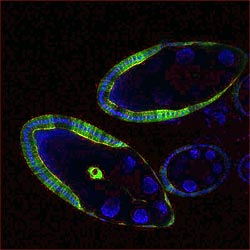IMP Scientists shed light on the “dark matter” of DNA

Fluorescence image of ovarian tissue of the fruit fly. DNA is stained in blue, the activity of enhancers is represented by the green colour.<br>Copyright: IMP<br>
Genome sequences store the information about an organism’s development in the DNA’s four-letter alphabet. Genes carry the instruction for proteins, which are the building blocks of our bodies.
However, genes make up only a minority of the entire genome sequence – roughly two percent in humans. The remainder was once dismissed as “junk”, mostly because its function remained elusive. “Dark matter” might be more appropriate, but gradually light is being shed on this part of the genome, too.
Far from being useless, the non-coding part of DNA contains so-called regulatory regions or enhancers that determine when and where each gene is expressed. This regulation ensures that each gene is only active in appropriate cell-types and tissues, e.g. haemoglobin in red blood cell precursors, digestive enzymes in the stomach, or ion channels in neurons. If gene regulation fails, cells express the wrong genes and acquire inappropriate functions such as the ability to divide and proliferate, leading to diseases such as cancer.
Despite the importance of gene regulatory regions, scientists have been limited in their ability to study them on a genome-wide scale. Their identification relied on indirect means, which were error prone and required tedious experiments for validating and quantifying enhancer activities..
Alexander Stark and his team at the IMP in Vienna now closed this gap with the development of a new technology called STARR-seq (self-transcribing active regulatory region sequencing), published online by Science this week. STARR-seq allows the direct identification of DNA sequences that function as enhancers and simultaneously measures their activity quantitatively in entire genomes.
Applying their technology to Drosophila cells, the IMP-scientists surprisingly find that the strongest enhancers reside in both regulatory genes that determine the respective cell-types as well as in broadly active “housekeeping” genes that are required for basic cell survival in most or all cells. In addition, they find several enhancers for each active gene, which might provide redundancy to ensure robustness of gene regulation.
The new method combines advanced sequencing technology and highly specialized know-how in bio-computing. It is a powerful tool which, according to Alexander Stark, will prove immensely valuable in the future. “STARR-seq is like a magic microscope that lets us zoom in on the regulatory regions of DNA. It will be crucial to study gene regulation and how it is encoded in the genome – both during normal development and when it goes wrong in disease.”
The paper „STARR-seq Reports Genome-Wide Quantitative Enhancer Activity Maps Revealing Complex cis-Regulation of Transcription“ by Cosmas Arnold et al. is published online by Science Express on January 17, 2013.
A scientific image to illustrate this press release can be downloaded from the IMP-Website: http://www.imp.ac.at/pressefoto-enhancer
About Alexander Stark
Alexander Stark joined the IMP as Group Leader in October 2008. Prior to his current position he was a postdoctoral fellow at the Broad Institute of MIT and Harvard and at CSAIL MIT. Stark studied biochemistry at the University of Tübingen and received his PhD from the EMBL in Heidelberg and the University of Cologne. The work of Alexander Stark is supported by a Starting Grant of the European Research Council ERC, awarded in 2009.
About the IMP
The Research Institute of Molecular Pathology (IMP) in Vienna is a basic biomedical research institute largely sponsored by Boehringer Ingelheim. With over 200 scientists from 30 nations, the IMP is committed to scientific discovery of fundamental molecular and cellular mechanisms underlying complex biological phenomena. Research areas include cell and molecular biology, neurobiology, disease mechanisms and computational biology. The IMP is a founding member of the Campus Vienna Biocenter.
Contact
Dr. Heidemarie Hurtl
IMP Communications
Tel.: (+43 1) 79730 3625
Mobile: (+43 1) 664 8247910
hurtl@imp.ac.at
Media Contact
All latest news from the category: Life Sciences and Chemistry
Articles and reports from the Life Sciences and chemistry area deal with applied and basic research into modern biology, chemistry and human medicine.
Valuable information can be found on a range of life sciences fields including bacteriology, biochemistry, bionics, bioinformatics, biophysics, biotechnology, genetics, geobotany, human biology, marine biology, microbiology, molecular biology, cellular biology, zoology, bioinorganic chemistry, microchemistry and environmental chemistry.
Newest articles

Silicon Carbide Innovation Alliance to drive industrial-scale semiconductor work
Known for its ability to withstand extreme environments and high voltages, silicon carbide (SiC) is a semiconducting material made up of silicon and carbon atoms arranged into crystals that is…

New SPECT/CT technique shows impressive biomarker identification
…offers increased access for prostate cancer patients. A novel SPECT/CT acquisition method can accurately detect radiopharmaceutical biodistribution in a convenient manner for prostate cancer patients, opening the door for more…

How 3D printers can give robots a soft touch
Soft skin coverings and touch sensors have emerged as a promising feature for robots that are both safer and more intuitive for human interaction, but they are expensive and difficult…





















